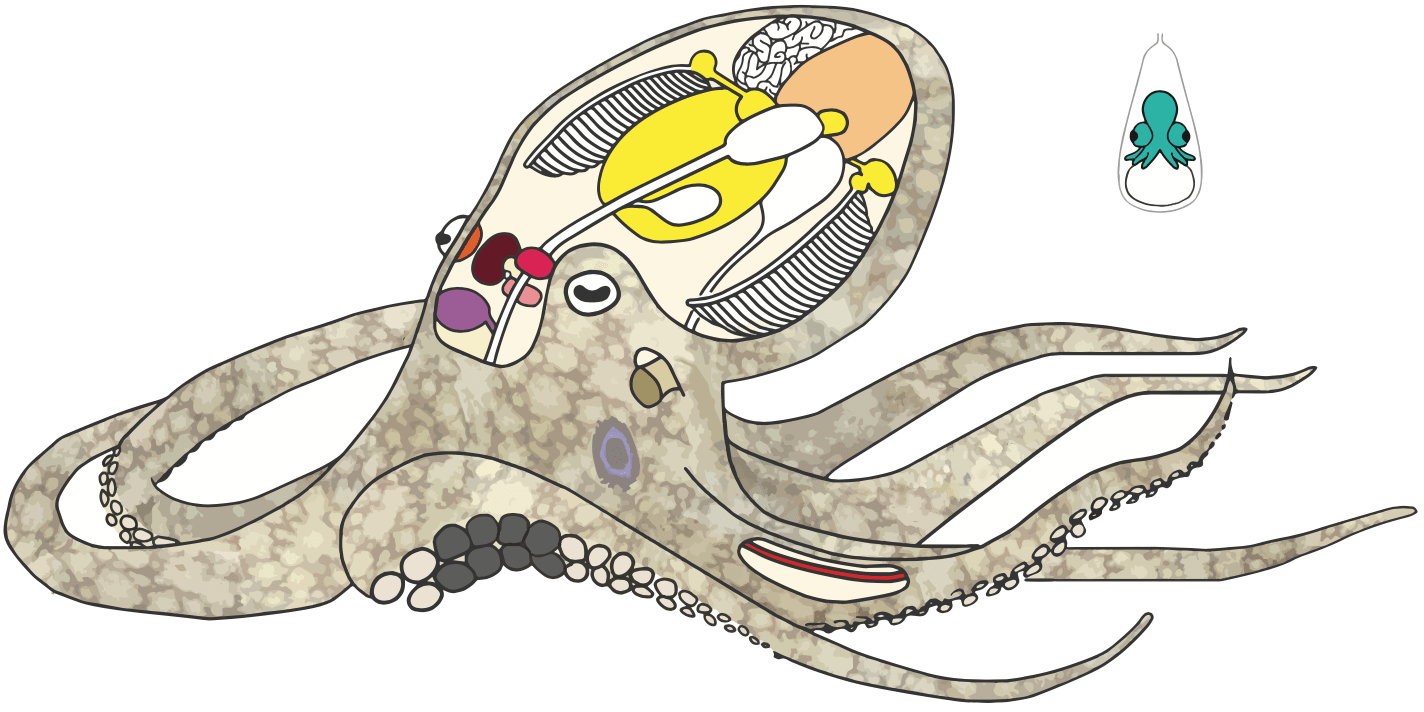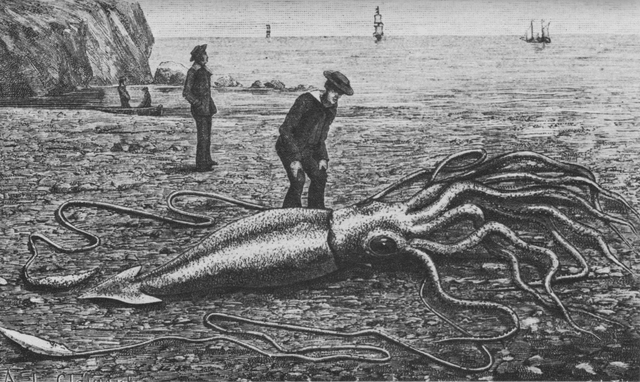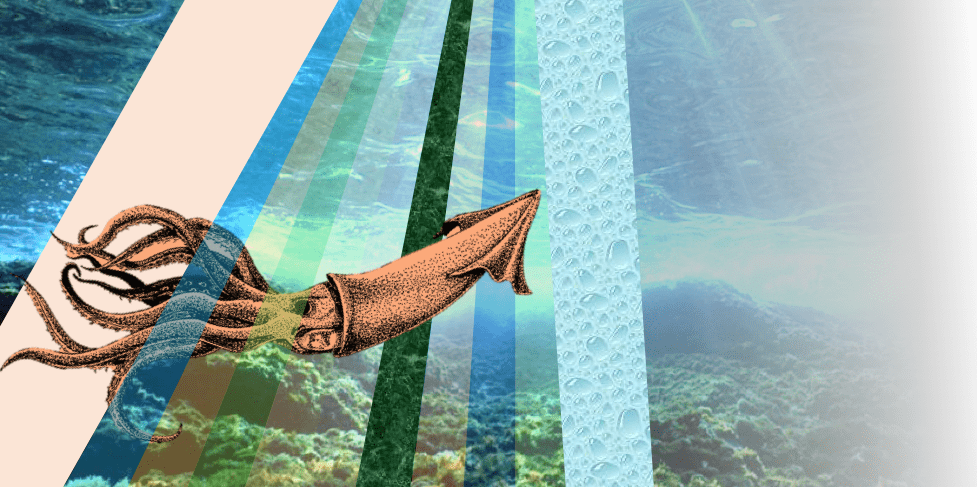Week #5: Octopus and squid
22 Apr 2018Hello! It’s been longer than I thought it would be. Maybe once a week was a little too ambitious, so my new plan is to send out an email every month or so.
Paper: The octopus genome and the evolution of cephalopod neural and morphological novelties, by Caroline B. Albertin et al. (Nature, 2015) [pdf].
Soundtrack: “The Love Life of the Octopus”, undersea footage from 1967 by Jean Painlevé, with music by Yo La Tengo.
This week’s paper is about the first whole sequencing of the octopus genome, in 2015. Looking at the genome of the octopus can tell us a lot about the evolutionary history of octopuses and other related species like squid. Prior to this paper, it was not known exactly how the octopus and squid developed such sophisticated “brains” (I’ll explain the quotes later), while other invertebrates did not. By inspecting the octopuses genome, we can learn a little more about how their genes might have evolved to support a more complicated brain structure.
Haven’t we already sequenced all the genomes?
You might have been under the impression that sequencing genomes was sort of a thing of the past. Given that we sequenced the human genome in the 2000s, I figured that by now we’d have made a good dent in sequencing the genomes of other species too.
In fact, no one has ever sequenced the entire genome of any mammal, including humans. (Good article on this here.) And we’ve got an even longer way to go with the rest of the animal kingdom.

In the image above, each green line around the circle represents one of the 8 million or so eukaryotic species we’ve discovered, while the blue and purple are bacteria and archaea. The red lines are the ones we’ve sequenced. In other words, we’ve barely even started. Part of this is because sequencing a genome is so expensive, both in terms of finance and computation. Imagine shredding up hundreds of copies of the same book, and trying to put the pieces back together to form a single book. That’s roughly how we sequence genomes.
Sequencing a genome probably won’t make you science-famous
One of my first questions about this paper was (imagine it said in that awful Jerry-Seinfeld-stand-up-routine voice): What’s the deal with whole genome sequencing? Can you really just pick a random animal, sequence its genome, and then you get to publish an article in Science or Nature?
Well, there are are a handful of projects that aim to sequence the genome of every single living species. The Genome 10k project, for example, aims to sequence 10,000 vertebrate genomes (one from each genus). Taking a look at their publication list, however, it’s clearly not true that merely sequencing a sunfish, for example, is enough to get you a paper in a high-profile journal.
Instead, I think what earns you a high-profile publication is using the sequence to learn something about those species whose development appears somewhat out of the ordinary. For example, sequencing the seahorse genome to understand why in seahorses, the males get pregnant and not the females. In this paper’s case, the out of the ordinary part about octopuses and squid is, roughly speaking, the fact that they have complex behavior at all. In particular, we might wonder how they can:
- use coconuts as tools
- disguise themselves as harmless fish or plants
- open jars
- learn mazes
Molluscs and cephalopods

This paper is about the genome of a single male California two-spot octopus (the cartoon above is from the paper), but the authors see their results as applying more generally to so-called “coleoid cephalopods,” a sub-class of species that includes octopuses, squid, and cuttlefish.
Octopuses, squid, and cuttlefish are all part of the mollusc phylum, which includes other, much dumber species such as clams, oysters, snails, and slugs. Molluscs are very common, making up about 25% of all known underwater species. (Most molluscs, it turns out, are just snails. Apparently, malacologists–or, “mollusc scientists,” if you’d prefer–are really good at identifying new species of snails.)
The fact that octopuses and squid are molluscs tells us two very key things: First, because they don’t have torsos, their testes and anus are in their heads. (The gonads are colored peach in the cartoon above.) And finally, like all molluscs with brains, their brains are wrapped around their esophagus, which means if they eat something too large they can get brain damage. (The two “brains,” or central ganglia, are in hot pink and light pink in the cartoon above.)
But coleoid cephalopods such as octopuses, squid, and cuttlefish–unlike most molluscs–don’t have a shell, which means they can signal via their skin either for camouflage, hunting, or mating. They also have arms/tentacles (as Wikipedia puts it, “Squid have spectacular tentacles”), swim via jet propulsion, and have complex sensory systems.
Obviously, cats can do amazing things too (open boxes, hide in boxes, rub their faces on boxes, etc.), but this is maybe less surprising because cats, like all vertebrates, have a central nervous system. So how is it that cephalopod behavior is so complex?
Complex behavior requires complex neural circuitry
If you want complex behavior, you need to develop a complex nervous system. But invertebrates, which make up a majority of all known animal species (in the ballpark of 98%), are not known for their sophisticated nervous systems. Vertebrates, on the other hand, are known for having a centralized brain, and much more complex behaviors as a result. However, it’s not just a relatively large brain size that leads to more complex behaviors. The thinking is that to evolve complex behaviors you first need a brain that supports speed. And most invertebrates are very slow (remember: snails).
The ability to move quickly comes down to the presence of speedy connections between neurons. If you think about what happens when a gazelle sees a tiger, for example, the gazelle’s retinal neurons need to quickly transmit information from the eye to the relevant part of the gazelle’s brain in order to trigger an escape response. One critical thing that vertebrates have that enables these quick responses is myelin, a conductive coating on neurons that enables neurons to transmit signals much faster and farther.

The problem is that most invertebrates, including cephalopods, don’t have myelin. (Cephalopods do have some thicker axons, which helps a bit, but this is only in certain parts of the brain.) So how do cephalopod brains get around this?
By examining the octopus genome, the authors found a clue: An increased expansion in a particular gene family that encode molecules known as “protocadherins.” Protocadherins are thought to help form local networks of neurons in the brain. And it turns out that cephalopod nervous systems show a lot of complexity in their local networks but not so much larger networks. This is likely because long-term networks would require myelin, which we know they don’t have. So, the authors conclude (emphasis mine):
"The expression of protocadherins in octopus neural tissues is consistent with a central role for these genes in establishing and maintaining cephalopod nervous system organization as they do in vertebrates."
This expansion in the protocadherin gene family appears to be an example of convergent evolution, because it evolved in cephalopods independent of it evolving in vertebrates. In this case, having more genes for protocadherins may have provided for the development of more complex neural circuitry, which might at least partially explain the sophisticated behaviors we see in cephalopods.
Summary
- Topic: Sequencing the octopus genome
- Why we care: Understanding the evolutionary/genetic origin of complex brains and behavior in cephalopods
- Conclusion: Among other things, more genes for protocadherin molecules may have enabled more complex neural circuitry
